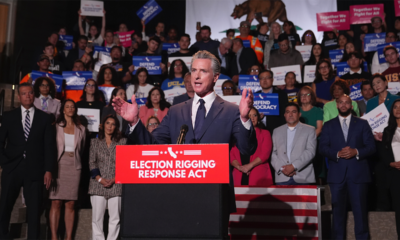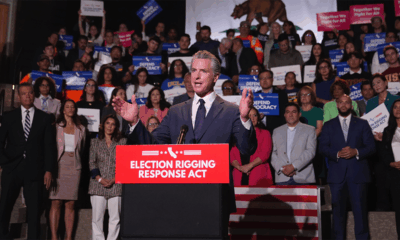California
Editorial: California Medi-Cal measure locks in special-interest funding

Proposition 35, the Medi-Cal funding measure on the Nov. 5 ballot, presents another example of special-interest ballot-box budgeting that limits the discretion of lawmakers and reduces flexibility to respond to fiscal crises. Voters should reject it.
If we’ve learned anything in the past few years, it’s that multibillion budget surpluses one year can morph into gigantic deficits the next. The governor and state lawmakers need flexibility to responsibly address the shortfalls.
California voters should not lock in funding allocations that favor doctors and hospitals over children and community health workers. Nor should they keep tying the hands of lawmakers, who must already contend with, for example, voter mandates for school funding, which must receive about 40% of the state budget; for prudent budget reserves; and for arts education.
At issue with Proposition 35 is a tax on health plans that provides $7.5 billion of the $161 billion needed to annually fund Medi-Cal — the federal-state health program for low-income people.
The tax is based on the number of people to whom the health plans provide coverage. The state leverages the tax money for matching funds from the federal government.
Medi-Cal, in turn, reimburses the health plans for almost all the tax, with the federal government covering the majority of the cost. In other words, it’s a tax that’s not really a tax but rather a way to pull in more federal money.
Proposition 35 is being sold as a measure that would secure that $7.5 billion in funding by permanently extending the tax on health plans. But this lock-in isn’t needed. State lawmakers, understanding how the tax leverages federal dollars, have generally levied and renewed it for nearly two decades and are incentivized to do so in the future.
Meanwhile, Proposition 35 would not only make the tax permanent, it would also dictate allocation of the spoils. It would pick winners and losers.
Not surprisingly, the winners include doctors, hospitals and emergency ambulance providers, which explains why they are major financial backers of the measure. Their funding would be protected and, in some cases, increased under Proposition 35.
Among the possible losers are community health workers, private nurses and children under age 5, who are currently protected from losing their Medi-Cal coverage.
To provide the additional funding for the winners under Proposition 35 and still preserve other Medi-Cal programs, the state would need to tap the general fund for another $1 billion to $2 billion annually in 2025 and 2026, according to the Legislative Analyst’s Office.
The current tax will expire at the end of 2026 unless the Legislature and the federal government extend it. But there’s every reason to believe state lawmakers will do their part, just as they have in the past.
Yet, Proposition 35 backers tout that their measure would make the tax permanent starting in 2027 — and use the notion of going after politically unpopular insurance companies for money as a selling point even though those companies will get their money back.
Backers of the ballot measure also say that the tax revenue has been diverted to bolster the state’s general fund. But the state this fiscal year will provide $62.4 billion to help fund Medi-Cal, including $35 billion from the general fund.
It’s fiscally reckless to keep using ballot measures to earmark unpredictable state revenues. Proposition 35, which is 43 pages long, “hamstrings our ability to have the kind of flexibility that’s required at the moment we’re living in,” says Gov. Gavin Newsom.
He’s right.
More funding for health care for the poor is a laudable goal. So are attempts to raise rates for doctors and other health care providers who serve Medi-Cal patients. Indeed, there are legitimate concerns about Medi-Cal patients not being able to find providers because doctors don’t want to take them on at low payment rates.
But the allocation of limited general fund money should be made when all the competing demands are weighed by state lawmakers. We shouldn’t be locking it in with a ballot measure few voters will ever understand.

California
CAL FIRE company officer training reaches record 2025 total in California

Record year for CAL FIRE training
The office of Governor Gavin Newsom said CAL FIRE has trained more than 650 Company Officers in 2025, marking a record year for leadership development across California.
According to the governor’s office, four Company Officer academies have operated at full capacity during 2025.
The newest site, the Atwater Training Center in Merced County, opened in July 2025 to meet rising training demand.
Existing facilities in Ione, Redding and Riverside have supported the expanded training programme.
The office said this training year reflects a sustained focus on developing professional leaders for CAL FIRE operations across the state.
Gavin Newsom, Governor of California, said: “Rapidly expanding our world-class firefighting force is just one piece of California’s unprecedented investment in fire protection and readiness.
“From new training facilities to the Southern California Emergency Operations Center, we’re building the infrastructure and workforce our communities need to face the climate challenges ahead.
“While Donald Trump undercuts federal readiness for mega-fires that threaten communities across the west, California continues to dominate with key investments in fire readiness and response.”
Company Officer Academy Class 25-14 graduation
The office confirmed that 38 CAL FIRE Company Officers have graduated from Company Officer Academy Class 25-14 at the Ione Training Center.
This cohort is described as the final class in the 2025 training cycle.
The graduates have completed an intensive syllabus and will move into leadership roles across the department.
CAL FIRE Director and Fire Chief Joe Tyler administered the oath to the new Company Officers.
Tyler’s keynote address highlighted the workload involved in delivering this year’s instruction.
CAL FIRE Director and Fire Chief Joe Tyler said: “This milestone year of training represents our commitment to the future of CAL FIRE and the safety of California.
“We recognize the achievement of these 38 students, as well as the dedication of our training staff who maintained exceptionally high standards while sustaining this record-setting pace.”
State investment in wildfire readiness and prevention
The governor’s office linked the graduation to wider state investment in wildfire response and prevention capabilities.
According to the office, California has doubled its spending on wildfire prevention and resilience efforts since 2020.
State figures report more than $2.5 billion allocated to wildfire resilience programmes.
An additional $1.5 billion is due to come from the 2024 Climate Bond.
California has also invested $173 million in community-based wildfire projects aimed at helping local areas protect themselves from wildfires.
The office described the firefighters graduating at the new training facility as an example of this funding in practice.
The governor’s office added that California has joined the Northwest Wildland Fire Fighting Compact.
This agreement expands mutual aid partnerships for major wildfire incidents to additional agencies across the US and Canada.
How expanded CAL FIRE capacity relates to sector priorities
The expansion of CAL FIRE Company Officer training and the opening of the Atwater Training Center in Merced County provide practical information for fire and rescue chiefs and senior officers tracking workforce development in US wildland agencies.
A record total of more than 650 Company Officers trained in 2025 indicates the scale of leadership capacity being built within CAL FIRE.
Training officers and instructors may note that four academies operated at full capacity, with a new site added to handle increased demand.
Emergency and disaster response managers can draw on the detailed figures on state investment, including more than $2.5 billion for wildfire resilience, $1.5 billion from the 2024 Climate Bond and $173 million for community-based projects.
Government departments and mutual aid coordinators will be directly affected by California’s decision to join the Northwest Wildland Fire Fighting Compact, which broadens access to partner resources during major wildfire incidents.
California
All lanes reopen on 5 Freeway in Oceanside after officer-involved shooting forces closure

OCEANSIDE, Calif. (KABC) — Hours after an officer-involved shooting prompted the full closure of the 5 Freeway in Oceanside, all lanes were reopened Saturday afternoon as the investigation continues.
“The 5 is closed in both directions between Oceanside and the Orange County border while police investigate a shooting,” Caltrans said in a social media post at 9:39 a.m., adding that drivers should use the 15 Freeway as an alternative route.
The Buena Park Police Department said its officers attempted to pull over a car for vehicle code violations just before 1 p.m. in the area of La Palma Avenue and San Marino Drive, but the car failed to stop and a pursuit ensued.
“At 1:05 a.m. we asked CHP to take over the pursuit. They did but requested our K-9 unit stay in the pursuit,” Buena Park police said in a statement.
Police said that at 2:10 a.m., the suspect vehicle was brought to a stop and then an officer-involved shooting occurred. It was not immediately known what led to the shooting.
A SigAlert was issued shortly after 2:30 a.m. between Harbor Drive in Oceanside and Christianitos Road in San Clemente, according to the California Highway Patrol.
As several lanes were reopened hours later, the Highway Patrol urged motorists to continue to use caution and watch for personnel in the area.
The investigation is ongoing.
Copyright © 2025 KABC Television, LLC. All rights reserved.
California
Chris Bell scores 21, sparks California to 91-67 victory over Sacramento State

BERKELEY, Calif. — – Chris Bell scored 17 of his 21 points in the first half and California cruised to a 91-67 victory over Sacramento State on Friday night in a campus game of the Empire Classic.
Bell and Justin Pippen combined for 29 points to help California take a 47-33 lead into the break. Bell sank 6 of 8 shots with three 3-pointers in the first 20 minutes.
John Camden’s 3-pointer capped an 11-2 run to begin the second half and the Golden Bears (5-1) were never threatened. Cal took its biggest lead at 81-47 on a 3-pointer by Camden with nine minutes left to play.
Pippen finished with 16 points and five assists. Dai Dai Ames also scored 16 and Camden totaled 14 points, five rebounds and five assists.
Brandon Gardner hit 4 of 5 from 3-point range and scored 19 to lead the Hornets (3-4). Mark Lavrenov had 14 points and Prophet Johnson notched his fifth double-double of the young season with 12 points and 11 rebounds.
The Golden Bears shot 50.8% overall and made 15 of 38 from beyond the arc (39.5%).
Sac State made only 18 of 67 shots (26.9%) overall, including 7 of 24 from distance. The Hornets made 24 of 30 free throws, while Cal sank 10 of 19.
—— Get poll alerts and updates on the AP Top 25 throughout the season. Sign up here and here (AP News mobile app). AP college basketball: https://apnews.com/hub/ap-top-25-college-basketball-poll and https://apnews.com/hub/college-basketballbr/]
Copyright © 2025 ESPN Internet Ventures. All rights reserved.
-
Business1 week ago
Fire survivors can use this new portal to rebuild faster and save money
-

 World6 days ago
World6 days agoFrance and Germany support simplification push for digital rules
-

 News7 days ago
News7 days agoCourt documents shed light on Indiana shooting that sparked stand-your-ground debate
-

 World7 days ago
World7 days agoCalls for answers grow over Canada’s interrogation of Israel critic
-

 World6 days ago
World6 days agoSinclair Snaps Up 8% Stake in Scripps in Advance of Potential Merger
-

 World1 week ago
World1 week ago2% of Russian global oil supply affected following Ukrainian attack
-
Business6 days ago
Amazon’s Zoox offers free robotaxi rides in San Francisco
-

 Politics7 days ago
Politics7 days agoDuckworth fires staffer who claimed to be attorney for detained illegal immigrant with criminal history



























